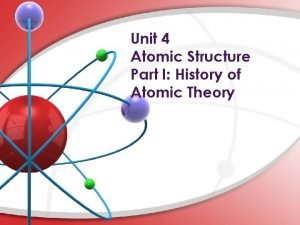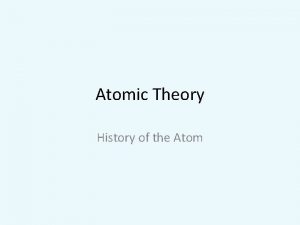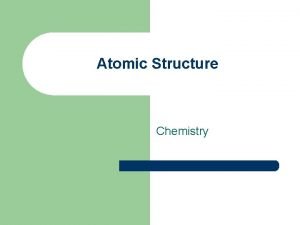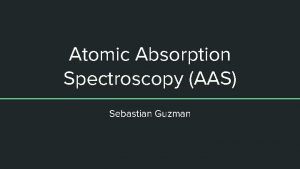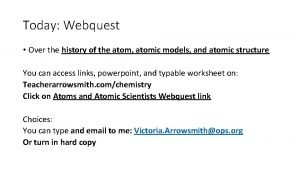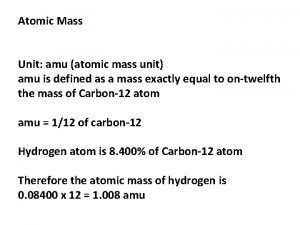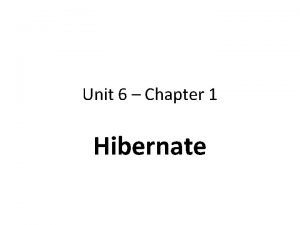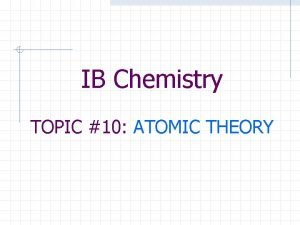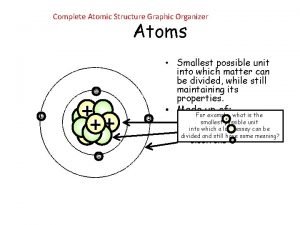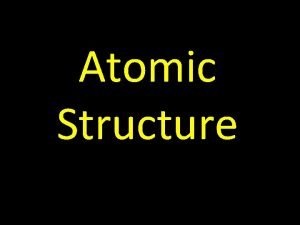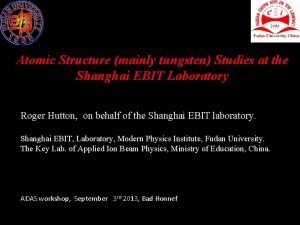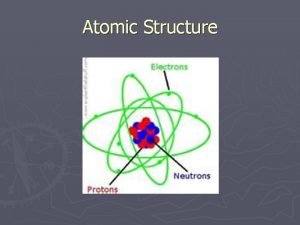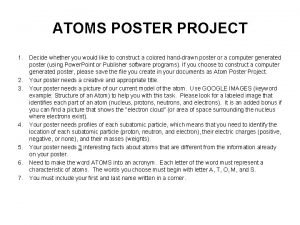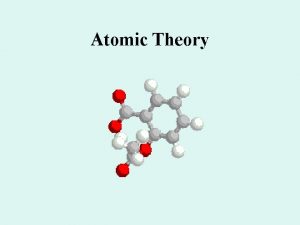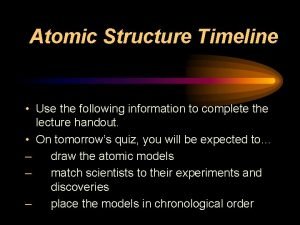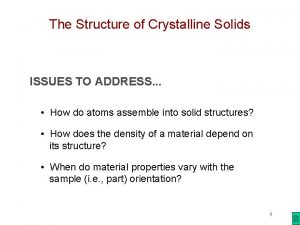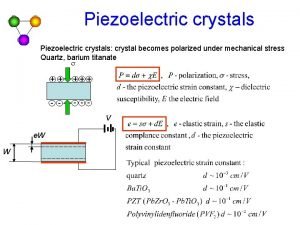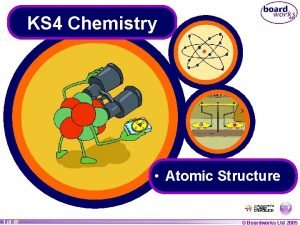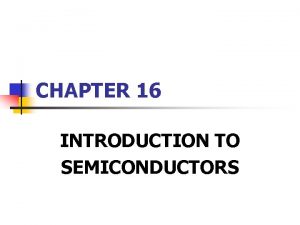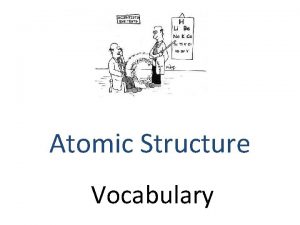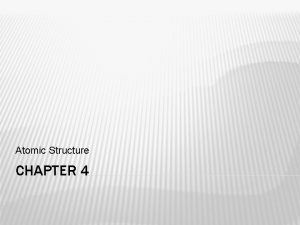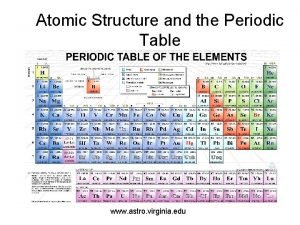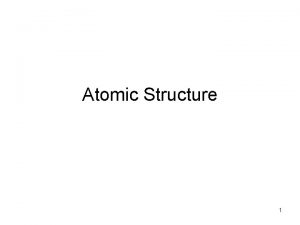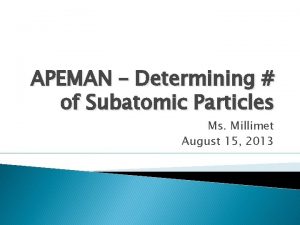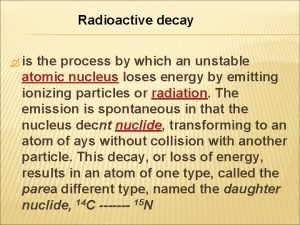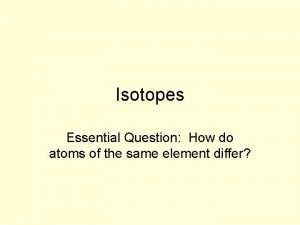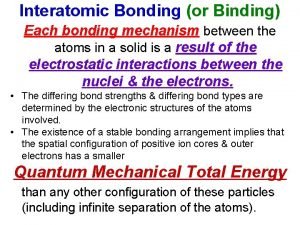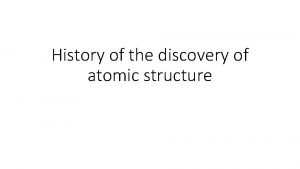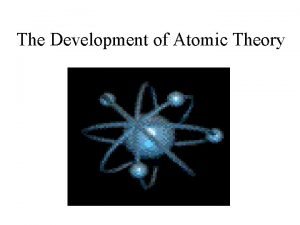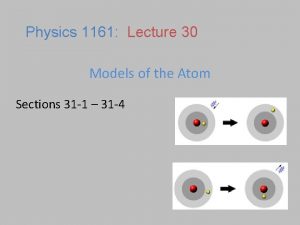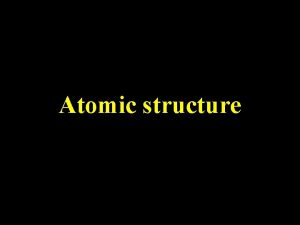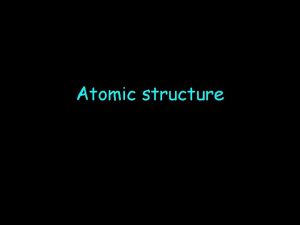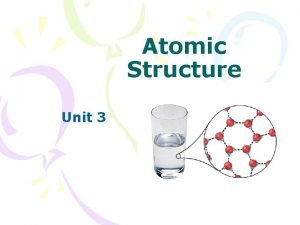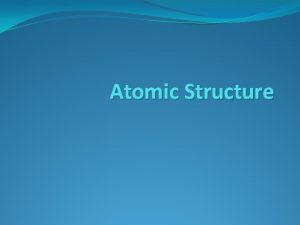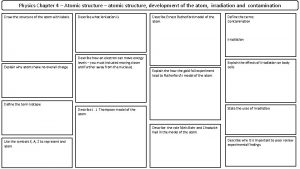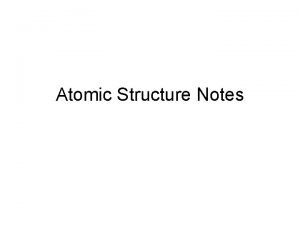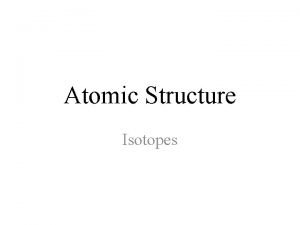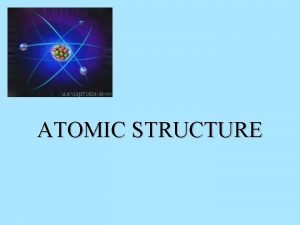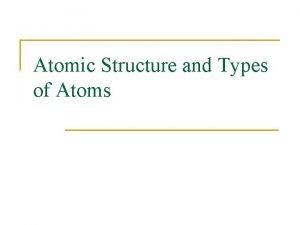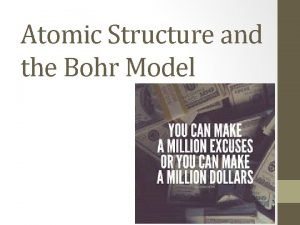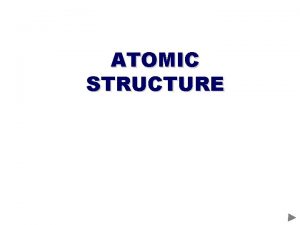Unit 4 Atomic Structure Part I History of


















































- Slides: 50

Unit 4 Atomic Structure Part I: History of Atomic Theory

Section 1 Developing the Theory of Matter Based on Atoms

• History of the Atom The understanding of matter has been a source of interest for humans for as long as history has been kept. • Theories of what we and all things are made of have included the likely to the absurd. • The main difference between all of theories has been dependent upon the current levels of science and technology. • As we should understand, SCIENCE, our system of knowledge for how the universe works and how we acquire new knowledge, IS INTERCONNECTED WITH TECHNOLOGY. • Meaning, our understanding of the world is limited to the sophistication of the tools we use draw conclusions and to access facts. •

• Where we’re going… Over the next few weeks you are going to learn everything you can about atoms and elements. • We’ll first discuss the history of the atom, then the structure, finally modern atomic theory. • In later lessons we’ll discuss the periodic table; the logic behind its construction and the properties of elements we observe. •

• Atomic Structure • Objectives: • • • Research and learn how theory of atoms have developed over time. Describe ancient Greek Models of matter. List the main points of Daltons atomic theory and describe evidence for the existence of atoms. Explain how Thompson and Rutherford used data from experiments to produce their atomic models. Understand the input from Bohr and Schrödinger in how we currently know how an atom is constructed.

• Part I • Clash of the Titans. Video Research • You picked up a handout today that has several scientists featured. These scientists are important to study for a few reasons. • First, you hopefully gain an appreciation for the hard work, sacrifice, and challenge it is to bring new information into the world. • Second, the stories of these scientists help to justify taking a cautious approach to what you believe as fact. • One day facts are likely to be proven false.

• Part I • Clash of the Titans. Video Research • All you have to do is fill out this chart with as much information as possible. • You will use this as research when establishing a timeline for theory of the atom in an upcoming assignment. • Listen closely for the names of the scientists involved. They kinda come in order, but a few are mentioned throughout. • Enjoy.

The Theory of the Atom: Clash of the Titans. To start your research into the discovery of the atom you will view this documentary. In this video, the host explains some of the more important scientists and their contribution. You’ll notice that the progression of this idea has been met with a significant amount of controversy. Think about this as you watch; was this process and easy one? Did the scientists featured have an easy time convincing their colleagues? Scientist: What Summarize this scientist’s theory and… Year? Explain some of the challenges (personal and/or professional) this scientist faced and Answer or complete any specific questions asked. Ludwig Boltzmann (2: 00 -6: 00) (3: 55) Theory: Challenges: Why was the discovery of the atom, whether it was “real or not”, so important? What was the driving force? Albert Einstein (6: 20 -11: 00) Theory: Challenges: (8: 10) Which theory did Einstein write about that inspired the discovery of the atom? (8: 40) What is “Brownian Motion”? Ernest Rutherford (12: 00 ) Theory: Challenges: (14: 40 -17: 00) Describe the correlation between phenomenon, such as radioactivity and X-rays, and atomic theory. (19: 30) What did Rutherford show the world? Niels Bohr (24: 00 ) Theory: Challenges: (28: 50) Did Bohr and Einstein get along? (26: 00) Summarize what Bohr’s “Quantum Jump” describes. Werner Heisenberg (30: 00 ) Theory: Challenges: (40: 00) According to Heisenberg, why can’t “an atom be visualized and understood”? (40: 50) This is called the Heisenberg __________ Principle. Erwin Schrödinger (31: 00 ) Theory: Challenges: Summary Who was declared triumphant in the journey to illustrate the atom’s true properties? Have we, any human being, ever seen an atom? Why do we trust that they are there?

• Discovery Assignment Atomic Theory Time-line Directions. Complete the worksheet, using your books for reference. Discover the year, the scientist’s theory, what this scientist’s evidence, the logic used, was for creating this theory, what the model’s name is, and finally draw the model. Scientist Democritus Aristotle Dalton Thomson Rutherford Bohr Schrödinger Year Theory/ Contribution to the atom model Evidence Model Drawing

• Atomic Structure • Objectives: • • • Research and learn how theory of atoms have developed over time. Describe ancient Greek Models of matter. List the main points of Dalton’s atomic theory and describe evidence for the existence of atoms. Explain how Thompson and Rutherford used data from experiments to produce their atomic models. Understand the input from Bohr and Schrödinger in how we currently know how an atom is constructed.

• Ancient Greek Models • The first theories advanced to explain what matter was came from Greek philosophers using mere philosophy and observation. This is known as empirical science. • • • 600 B. C. Thales : believed everything’s made of water 500 B. C. Xenophanes : everything’s made of water & earth. 440 B. C. Empedocles : suggested there were 4 elements; earth, water, air & fire (borrowed from Buddhist theories of the 4 bhūtas) and everything was a combination if these. 400 B. C. Democritus : Many different elements with a limit to how small you could go. 340 B. C. Aristotle : 4 elements with no limit to how much they could be split but they could transform into each other.

• Atomic Structure • Ancient Greek Models of Atoms • Democritus (400 B. C. ) • • All matter could be broken down into very small particles that could not be split. He called the particles “atoms” from the Greek word atomos , which means ‘uncut’ He thought there were different types of atoms based on the substance’s properties. His theories were based on logic & observation

• Atomic Structure • Aristotle • • • Contrary to Democritus, he believed all matter could be divided over and over into the same four elements. There were 4 elements: fire, air, earth and water. The elements had combinations of 4 qualities: hot, cold, dry, and wet There was a 5 th …the stuff that makes up the heavens & spirit that could turn anything into gold. This lead to the study of alchemy… a 2, 000 year hunt for a nonexistent formula for

• The Atomic Theory’s Dark Ages… • The geo-centric, neo-centric view of atoms, matter, and the universe were perpetuated for thousands of years with the help of religious institutions and bad science. • After the dark ages, scientists began using good science… the scientific method… to discover the truth about matter and atoms.

• Atomic Structure: Dalton (18 05) • Dalton’s Atomic Theory • Studied behavior of gases. • • Helped formulate gas theories an d laws. Through his experiments claime d that gas and matter consists of individual particles… like Democritus. →Confirmed Lavoisier’s Law of the Conservation of Matter →Measured masses of elements that combine when compounds are formed during reactions. →Noticed that ratio of elements in a compound never changed no matter how much was added. →Compounds, therefore, have a fixed composition.

• Atomic Structure: Dalton’ s Theory • • His conclusion… All matter is made up of individual solids particles called atoms, which cannot be divided. Ø All Elements are composed of atoms Ø All atoms of the same element have the same mass, and atoms of different elements have different masses. Ø Compounds contain atoms of more than one element. Ø In a particular compound, atoms of different elements always combine in the same way.

• Dalton’s Atomic Model • He believed that atoms were solid. Ø His models were solid wooden spheres. What is a model again? (- Scientific models are physical or mental representation of an object or an event. ) • He came to a very sound conclusion but this, as science does, was revised and refined…

• Atomic Structure. Thomson (1897) • Thomson’s Model of the Atom • At the time of his experiments, it was known that some materials have a positive or negative charge. What was known at the time. . . Objects with like charges repel, unlike charges attract. Electric Current: Some charged particles can flow from one location to another. When charged particles flow it is called an electric current. Also known was that atoms were neutral particles.

• Atomic Structure • Evidence for Subatomic Particles • Thomson did experiments to demonstrate that particles came from the inside of atoms. • Thomson provided first evidence that atoms are made of even smaller particles… electrons… and then the logical opposite, protons. • This provided some consideration to the possibility that there were smaller particles, other than just the elements, that composed the atom.

• Thomson’s Cathode Ray Experiment The positively charged plate attracted the negatively charged beam.

• Atomic Structure • Thomson’s Model: Plum Pudding • • • Atoms have no overall electrical charge…It’s neutral. Thomson’s model scatters negative charges throughout positively charged matter. Model is called the “plum pudding” atomic model. Negatively charged particles in… positively charged matter

• Atomic Structure. Rutherford (1911) • Rutherford’s Atomic Theory • Ernest Rutherford found that uranium puts out fast-moving particles that are positively charged. • These positive particles are called alpha particles. • Rutherford disproved Thomson when he determined that the positive charge of an atom is not evenly spread throughout the atom as previously thought.

• Atomic Structure • Discovery of The Nucleus • • Rutherford suggested the positive charges were concentrated in the central part of the atom. He called it the nucleus. The nucleus is in the center, it is a dense area in the center, it has mass and has a positive charge. All of an atom’s positive charge is concentrated in the nucleus.

• Rutherford’s “Gold Foil” Experiment… How he did it Isolated particles moving directly at the gold foil

• Rutherford’s Experiment • What was predicted… if Thompson was right. • + What he saw… made Thompson wrong. why? Btw. Like charges repel each other + + +

• Check your understanding a. Dalton c. Thomson b. Indivisible, solid spheres d. Negative charges evenly scattered through a positively charged mass of matter (plum pudding model) e. Deflection of alpha particles passing through gold foil

• This is the model you know so far… • This is a representation of Rutherford’s model. • It is called the “solar system” model because it- placed a nucleus in the +++ center of electrons orbiting around it. +++ - - You are going to learn the newest versions today.

• Modern Atomic Theory Niels Bohr (1913) • • • To begin to understand how elements behave you need to understand how the electrons are distributed. To do that let’s look at the man who discovered it. A contemporary of Rutherford, Niels Bohr (1885 -1962) from Denmark discovered something that Rutherford didn’t. He focused on the negative charges and found the electrons. He discovered quite a bit more though.

• Bohr’s Model of the Atom… • • He was first to really focus on where electrons were in relation to the nucleus. He mathematically proved that the electrons existed in different, particular orbits around the nucleus. Not just all in the same one or randomly. The orbital the electron existed in was dependent upon how much energy the electron had. Bohr’s model looks like a model of the solar system with planets orbiting the sun. • The difference between Bohr’s and Rutherford’s model is Bohr’s places electrons in differing orbits that he called energy levels. •

• What do you notice about the differences between them? • Bohr’s Model • Bohr’s is similar to Rutherford’s as it has a nucleus surrounded by space. The main difference is that Bohr’s model places the electrons in different orbits around the nucleus. • Rutherford

• Bohr’s V. Rutherford’s - - - +++ +++ - - Different Orbits - Same Orbit -

• Modern Atomic Theory Energy Levels • There are facts about Bohr’s model that you should remember. • • Bohr model places electrons in a specific orbit around the nucleus based upon their energies. • The orbits therefore are called energy levels. Electrons move with constant speed within their particular orbital based upon their energy. When an atom gains or loses energy, (such as being heated or cooled) the energy of the electron changes. When energy changes the electrons may jump from one energy level to the next, up or down, but cannot exist inbetween.

ne En rg • y. Bohr’s Model & er (H g y( ea He t) at) En er gy The Introduction of Energy - (H ea t) - - - +++ - - -

• Energy Levels…The Proof • • • The proof of the multiple energy levels is evident when considering the measured energy inputs and outputs. Scientists can record how much energy is given to an atom. The energy is absorbed by the atom for awhile. The atom will then give that energy back to the environment as it cools. The energy can be measured as it’s released but interesting things also happen. Atoms can emit light while the electrons are moving down energy levels, as the atom’s losing energy.

• Bohr’s Model & The Release of Energy En e g y ( r - - - t) He a Sometimes the atom simply releases energy and becomes more stable Energy (Heat) +++ - - En - er gy (H ea t) -

Ligh t • Bohr’s Model & The Release of Energy Ligh t Sometimes ht the atom g i L emits light as it releases energy Ligh t ht r g y ( - t) He a - Lig En e - - Energy (Heat) +++ - - En Light ht (H ea t) - g Li - er gy

• Modern Atomic Theory Bohr’s model was correct about one specific thing. • That electrons move in different energy levels. • He was challenged on proving the consistency in which they move. • His theory was supplemented by other scientists, namely Schrödinger , until the latest and most widely accepted model of the atom existed. • The Electron Cloud Model •

• Schrödinger (1926) • By the time Bohr and his protégé Heisenberg, were completing their theory based on Quantum Mechanics, it had gained enough popularity that critics were challenging it. • Schrödinger couldn’t accept all of Bohr’s theory. • He used probabilities to generate a next generation interpretation of Bohr’s model, that took into account the fact that no one could ever know both the location and speed of an electron.

• Schrödinger • Can you identify where the electron is? +++

• The Electron Cloud Model • Schrödinger’s electron cloud model suggests that the location of an electron can’t be really predicted; only the probability of the likelihood an electron would be there. • • Probability is used to determine where an electron is likely to be at any particular moment in time. What is probability? The problem with Schrödinger’s model is that there hasn’t been any 3 -D model that can express probability accurately, maybe it just can’t be done. • The most acceptable model represents the probability of an electron being in any area by regions being more heavily shaded when there is a higher chance of an electron being there. • The model that we use to represent an atom, therefore, is a combination of Bohr’s Orbital Model and Schrödinger’s Electron Cloud model. •

• The Electron Cloud/Bohr Model • The Electron Cloud Model Bohr Model Ultimately, scientists use the electron cloud theory with Bohr’s orbitals to describe the possible locations of electrons around the nucleus, using probability. Electrons are there, but they don’t really have to be there.

• Let’s Review the History of the Atomic Model • Dalton Solid Sphere • 1803 •

• The Evolution of the Atomic Model • Thomson Model Plum Pudding • 1897 • + + + + + - - + + +

• The Evolution of the Atomic Model • Rutherford Model Nucleus & Orbitals • 1911 •

• The Evolution of the Atomic Model • Bohr Electrons in Separate Orbitals • 1913 •

• The Evolution of the Atomic Model • Schrödinger Electron Cloud • 1926 • • This, along with Bohr’s model, it the one that is used today.

• Schrödinger • Can you identify where the electron is? +++

• Modern Atomic Theory • Atomic Orbitals • • • Schrödinger’s electron cloud, based upon his famous Wave Equation, is a good approximation of how electrons behave in their orbitals. However, it’s easier to discuss atomic and electron behaviors when using Bohr’s model. For that reason we will use Bohr’s model to help explain the behaviors of electrons from now on out.

• The Complete Atomic Model • Bohr • Models The most widely accepted theory on the construction of an atom used to illustrate the characteristics of electron behavior…

• Section 1 Quiz: 1. 2. 3. 4. What did Aristotle say about matter? What did Democritus say about matter? How did their opinions differ? Draw on a sheet of paper the models for… a) b) c) 5. Dalton Thompson Rutherford Describe what each of these three claimed about matter and atoms.
 Unit 4 atomic structure
Unit 4 atomic structure Relative atomic mass of beryllium
Relative atomic mass of beryllium Periodic tremds
Periodic tremds Atomic radius
Atomic radius Is atomic mass and relative atomic mass the same
Is atomic mass and relative atomic mass the same Distinguish between mass number and atomic mass.
Distinguish between mass number and atomic mass. Atomic number vs atomic radius
Atomic number vs atomic radius History of atomic models timeline
History of atomic models timeline 1930 modern atom teorisi
1930 modern atom teorisi Plum pudding model
Plum pudding model Atomic absorption spectroscopy history
Atomic absorption spectroscopy history Atomic structure webquest
Atomic structure webquest Unit 10, unit 10 review tests, unit 10 general test
Unit 10, unit 10 review tests, unit 10 general test Is atomic mass a whole number
Is atomic mass a whole number Define atomic mass unit
Define atomic mass unit Carbon amu
Carbon amu Hibernate introduction
Hibernate introduction Define the atomic mass unit
Define the atomic mass unit Atomic mass unit
Atomic mass unit Atomic mass unit
Atomic mass unit Atomic structure and properties ap chemistry
Atomic structure and properties ap chemistry How electrons are arranged in an atom
How electrons are arranged in an atom Atomic universe theory
Atomic universe theory Atomic structure of a conductor
Atomic structure of a conductor What is calcium ionization energy
What is calcium ionization energy First ionization energy of calcium
First ionization energy of calcium Basic parts of an atom graphic organizer
Basic parts of an atom graphic organizer Z atomic symbol
Z atomic symbol Tungsten atomic structure
Tungsten atomic structure 460 democritus atom model
460 democritus atom model Atoms poster
Atoms poster History of the atom graphic organizer
History of the atom graphic organizer James chadwick atomic model
James chadwick atomic model Ap chemistry atomic structure and periodicity
Ap chemistry atomic structure and periodicity Atomic packing factor of fcc structure is
Atomic packing factor of fcc structure is Piezoelectric crystal atomic structure
Piezoelectric crystal atomic structure Boardworks atomic structure
Boardworks atomic structure Atomic structure of semiconductor
Atomic structure of semiconductor Chapter 4 atomic structure vocabulary
Chapter 4 atomic structure vocabulary Chapter 4 atomic structure
Chapter 4 atomic structure Structure of periodic table
Structure of periodic table Atomic structure
Atomic structure How to use ape man
How to use ape man Ap chemistry chapter 7 atomic structure and periodicity
Ap chemistry chapter 7 atomic structure and periodicity Magnesium element drawing
Magnesium element drawing Tungsten atomic structure
Tungsten atomic structure What does the atomic number represent
What does the atomic number represent Atomic structure and interatomic bonding
Atomic structure and interatomic bonding Discovery of atomic structure
Discovery of atomic structure Atomic structure
Atomic structure Radius of bohr orbit formula
Radius of bohr orbit formula
